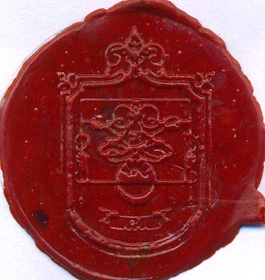We'll come back later to the idea that people are gifts to the church. For now I'll just make the statement without enlarging on it. But what of the 'seal'? We covered this yesterday, but we can draw more from 1 Corinthians 9:2.
 |
| A wax seal |
It would have to be a material that could be moulded so it could be stamped with a signet ring, and it would need to set hard so that the pattern would not be lost in transit. Many materials have been used for this purpose. Hot wax can be stamped and sets hard when it cools. Clay can be stamped and sets when it dries. Bitumen was used in Roman times and hardens as it cools; good supplies were available from the Red Sea and elsewhere.
In what way were the believers in Corinth stamped with an image? They were stamped with the image of Christ. Jesus is the one who wears the signet ring. He is the one who marks us as authentic followers and as authentic communities, the ekklesia, the church. He stamps us by pouring his Spirit over us and into us and through us, and we become a little more like him.
Paul could see this growing evidence of their Christlikeness, and it was proof that he had laid the right foundation. It was, therefore, a seal of his apostleship. He had, we might say, 'apostled' well in Corinth and he continues this work in his letter.
Whose stamp do we see among those we have taught and counselled? Do we see our own stamp? Or do we see Jesus' stamp? It had better be the King's stamp, the stamp of King Jesus. If not, we have built in vain and our work will be destroyed in the fire (1 Corinthians 3:12-15).

No comments:
Post a Comment